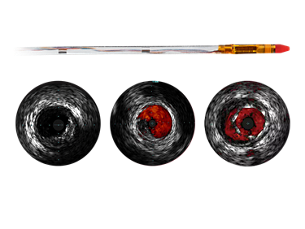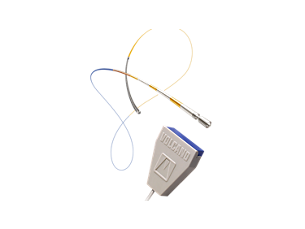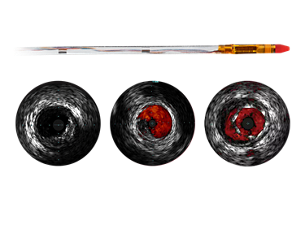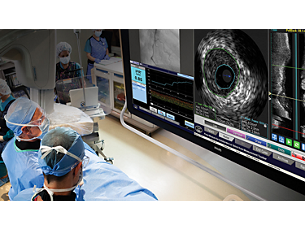Especificações
- Requisitos de energia
-
Requisitos de energia Entrada do sistema - 100 V-120 V, 50/60 Hz, 220-240 V, 50/60 Hz, 600 VA
Monitor - 100-240 V, 50/60Hz, 93 VA
Estação de trabalho - 100-240 V, 50/60 Hz, 250 VA
-
- Entradas
-
Entradas Saída de vídeo do sistema angiográfico - Analógico ou digital
Sistema IVUS - Sistemas Philips Volcano Core SW versão 3.2.2 e superiores
Cateter IVUS - Cateteres Eagle Eye Platinum
Sinal ECG - Entre em contato com o representante local da Philips Volcano para compatibilidade
-
- Medidas
-
Medidas Estação de trabalho - Altura: 16,5", 39,6 cm; Largura: 6,75", 16,2 cm; Profundidade: 21,25", 51 cm
Controlador de cabeceira - Altura: 1,5", 3,7 cm; Largura: 4,2", 10,7 cm; Profundidade: 3", 7,6 cm
Monitor - Altura: 15-19", 41-56 cm; Largura: 15,8", 40,2 cm; Profundidade: 10", 24,7 cm
-
- Informações do pedido
-
Informações do pedido Sistema de orientação de precisão SyncVision - Sync002
-
- Requisitos de energia
-
Requisitos de energia Entrada do sistema - 100 V-120 V, 50/60 Hz, 220-240 V, 50/60 Hz, 600 VA
Monitor - 100-240 V, 50/60Hz, 93 VA
-
- Entradas
-
Entradas Saída de vídeo do sistema angiográfico - Analógico ou digital
Sistema IVUS - Sistemas Philips Volcano Core SW versão 3.2.2 e superiores
-
- Requisitos de energia
-
Requisitos de energia Entrada do sistema - 100 V-120 V, 50/60 Hz, 220-240 V, 50/60 Hz, 600 VA
Monitor - 100-240 V, 50/60Hz, 93 VA
Estação de trabalho - 100-240 V, 50/60 Hz, 250 VA
-
- Entradas
-
Entradas Saída de vídeo do sistema angiográfico - Analógico ou digital
Sistema IVUS - Sistemas Philips Volcano Core SW versão 3.2.2 e superiores
Cateter IVUS - Cateteres Eagle Eye Platinum
Sinal ECG - Entre em contato com o representante local da Philips Volcano para compatibilidade
-
- Medidas
-
Medidas Estação de trabalho - Altura: 16,5", 39,6 cm; Largura: 6,75", 16,2 cm; Profundidade: 21,25", 51 cm
Controlador de cabeceira - Altura: 1,5", 3,7 cm; Largura: 4,2", 10,7 cm; Profundidade: 3", 7,6 cm
Monitor - Altura: 15-19", 41-56 cm; Largura: 15,8", 40,2 cm; Profundidade: 10", 24,7 cm
-
- Informações do pedido
-
Informações do pedido Sistema de orientação de precisão SyncVision - Sync002
-
- 1. Costa, Angiolillo DJ, Tannenbaum M, et al. Impact of Stent Deployment Procedural Factors on Long-term Effectiveness and Safety of Sirolimus-Eluting Stents (Final results of the Multicenter Prospective STLLR Trial). Am J Cardiol. 2008; 101(12):1704-1711.
- 2. Renata Rogacka, Azeem Latib, Antonio Colombo. IVUS-Guided Stent Implantation to Improve Outcome: A Promise Waiting to be Fulfilled. Curr Cardiol Rev. 2009;5(2):78–86.
- 3. Witzenbichler B, Maehara A, Weisz G, et al. Relationship Between Intravascular Ultrasound Guidance and Clinical Outcomes After Drug-Eluting Stents: The ADAPT-DES Study. Circulation. 2014;129:463-470.
- 4. 202-0013.53 SRS, Sync-Rx System pg 19,24.
- 5. Jakabcin J1, Spacek R, Bystron M, et al. Long-term health outcome and mortality evaluation after invasive coronary treatment using drug eluting stents with or without the IVUS guidance. Randomized control trial. HOME DES IVUS. Catheter Cardiovasc Interv. 2010;75(4):578-583.
- 6. 209-0030.02 Test Rpt, Use Validation, SyncVision. Pg. 9, Section 10.3; pg 14 – results.
- 7. 505-0100.18, Operator’s Manual. (pg 34).
- 8. 211-0013.31 Test Protocol, Volcano Sync-Rx Wizard phase; 211-9913.07 Verification Protocol, Sync-Rx Co-Registration.
- 9. Patel, et al. ACCF/SCAI/STS/AATS/AHA/ASNC/HFSA/SCCT 2012 Appropriate use criteria for coronary revascularization focused update: a report of the American College of Cardiology Foundation Appropriate Use Criteria Task Force, Society for Cardiovascular Angiography and Interventions, Society of Thoracic Surgeons, American Association for Thoracic Surgery, American Heart Association, American Society of Nuclear Cardiology, and the Society of Cardiovascular Computed Tomography. J Am Coll Cardiol. 2012;59(9):857-881.
- 10. Kim SH, Kim YH, Kang SJ, et al. Long-term outcomes of intravascular ultrasound-guided stenting in coronary bifurcation lesions. Am J Cardiol. 2010;106(5):612-618.
- 11. Patel Y, Depta JP, Novak E, et al. Long-term outcomes with use of intravascular ultrasound for the treatment of coronary bifurcation lesions. Am J Cardiol. 2012;109(7):960-965.
- 12. Davies JE, et al. Coronary artery physiological stenosis mapping: application of pressure wire technology to measure stenosis significance, length, and predict the outcome of intervention. Abstract presented at PCR 2014
- 13. An iFR cut-point of 0.89 matches best with an FFR ischemic cut-point of 0.80 with a specificity of 87.8% and sensitivity of 73.0%. (iFR Operator’s Manual 505-0101.23)
- 14. Fractional Flow Reserve–Guided PCI versus Medical Therapy in Stable Coronary Disease. N Engl J Med. 2012;367(11):991-1001.
- *Data on file





